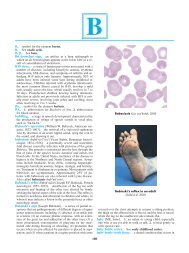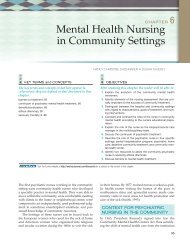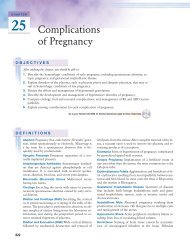Guidelines for Dietary Planning - Coursewareobjects.com ...
Guidelines for Dietary Planning - Coursewareobjects.com ...
Guidelines for Dietary Planning - Coursewareobjects.com ...
You also want an ePaper? Increase the reach of your titles
YUMPU automatically turns print PDFs into web optimized ePapers that Google loves.
342 PART 2 | Nutrition in the Life Cycle<br />
NATIONAL GUIDELINES<br />
FOR DIET PLANNING<br />
Within the past 30 years, attention has been focused increasingly<br />
on the relationship of nutrition to chronic diseases and<br />
conditions. Although this interest derives somewhat from the<br />
rapid increase in number of older adults and their longevity, it<br />
is also prompted by the desire to prevent premature deaths<br />
from diseases such as coronary heart disease, diabetes mellitus,<br />
and cancer. Approximately two thirds of deaths in the United<br />
States are caused by chronic disease.<br />
Current <strong>Dietary</strong> Guidance<br />
in the United States and Canada<br />
Eating can be one of life’s greatest pleasures. People eat <strong>for</strong><br />
enjoyment and to obtain energy and nutrients. Although<br />
many genetic, environmental, behavioral, and cultural factors<br />
affect health, diet is equally important <strong>for</strong> promoting<br />
health and preventing disease.<br />
In 1969, then President Nixon convened the White<br />
House Conference on Nutrition and Health (White<br />
House, 1970). Increased attention was being given to prevention<br />
of hunger and disease. The development of dietary<br />
guidelines in the United States began with the 1977<br />
report of the U.S. Senate Select Committee on Nutrition<br />
and Human Needs called <strong>Dietary</strong> Goals <strong>for</strong> the United<br />
States (U.S. Senate Select Committee on Nutrition and<br />
Human Needs, 1977).<br />
In addition to these dietary guidelines, several other important<br />
government or expert reports have addressed dietary<br />
re<strong>com</strong>mendations <strong>for</strong> healthy Americans. Previous Surgeon<br />
CLINICAL INSIGHT<br />
Nutrition Re<strong>com</strong>mendations <strong>for</strong> Canadians<br />
The revision to Canada’s Food Guide to Healthy Eating<br />
was released in 2007 and developed age- and genderspecifi<br />
c food intake patterns. These age- and gender-specifi c<br />
suggestions include 4 to 7 servings of vegetables and fruits, 3<br />
to 7 servings of grain products, 2 to 3 servings of milk or milk<br />
alternatives, and 1 to 3 servings of meat or meat alternatives.<br />
Unlike MyPyramid in the United States, Canada’s Eating<br />
Well with Canada’s Food Guide contains four food groupings<br />
presented in a rainbow shape (Health Canada, 2007) (see<br />
Figure 12-2). Tips include:<br />
• Consume no more than 400-450 mg of caffeine per day.<br />
• Eat at least one dark green and one orange vegetable each<br />
day.<br />
• Make at least half of grain products <strong>com</strong>sumed each day<br />
whole grain.<br />
• Compare the Nutrition Facts table on food labels to<br />
choose products that contain less fat, saturated fat, trans<br />
fat, sugar, and sodium.<br />
General’s Reports on Nutrition and Health and the National<br />
Academy of Sciences (NAS) have provided similar qualitative<br />
or quantitative dietary re<strong>com</strong>mendations. In Canada, dietary<br />
re<strong>com</strong>mendations are prepared by Health Canada (see Clinical<br />
Insight: Nutrition Re<strong>com</strong>mendations <strong>for</strong> Canadians).<br />
<strong>Guidelines</strong> directed toward prevention of a particular<br />
disease, such as those from the National Cancer Institute,<br />
the American Diabetes Association, The American Heart<br />
Association, and the National Heart, Lung, and Blood Institute’s<br />
cholesterol education guidelines, contain re<strong>com</strong>mendations<br />
unique to particular conditions. The American Dietetic<br />
Association (ADA) (2002) published a position<br />
statement stating that all foods can fi t into a healthful diet<br />
when the total diet, or overall pattern of food eaten, is consumed<br />
in moderation with appropriate portion sizes and<br />
<strong>com</strong>bined with regular physical activity. The various guidelines,<br />
summarized in Box 12-1 can be used by health counselors<br />
throughout most of the developed world.<br />
Implementing the <strong>Guidelines</strong><br />
The task of planning nutritious meals centers on including<br />
the essential nutrients in suffi cient amounts as outlined in<br />
the newest DRIs, in addition to appropriate amounts of<br />
energy, protein, carbohydrate (including fi ber and sugars),<br />
fat (especially saturated and trans-fats), cholesterol, and salt.<br />
Suggestions are included to help people meet the specifi cs<br />
of the re<strong>com</strong>mendations. When specifi c numeric re<strong>com</strong>mendations<br />
differ, they are pres ented as ranges.<br />
The MyPyramid Food Guidance System, shown in Figure<br />
12-1, offers a method <strong>for</strong> determining appropriate patterns<br />
<strong>for</strong> daily food choices based on servings from the fi ve major<br />
food groups. The MyPyramid system replaces the Food<br />
• Drink skim, 1% or 2% milk, or <strong>for</strong>tifi ed soy beverages<br />
each day. Check the food label to see if the soy beverage is<br />
<strong>for</strong>tifi ed with calcium and vitamin D.<br />
• Include a small amount (30-45 ml [2-3 Tbsp]) of<br />
unsaturated fat each day to get the fat needed.<br />
• Limit the intake of soft drinks, sports drinks, energy<br />
drinks, fruit drinks, punches, sweetened hot and cold<br />
beverages, and alcohol.<br />
• Eat at least two Food Guide Servings of fi sh each week.<br />
• Build 30-60 minutes of moderate physical activity into<br />
daily life <strong>for</strong> adults and at least 90 minutes a day <strong>for</strong><br />
children and youth.<br />
Data from Health Canada: Eating well with Canada’s food guide, ©Her<br />
Majesty the Queen in Right of Canada, represented by the Minister of<br />
Healthy Canada, 2007, available at www.hc-sc.gc.ca/fn-an/food-guidealiment,<br />
accessed February 8, 2007.







